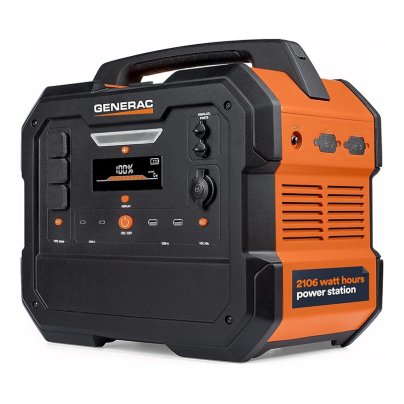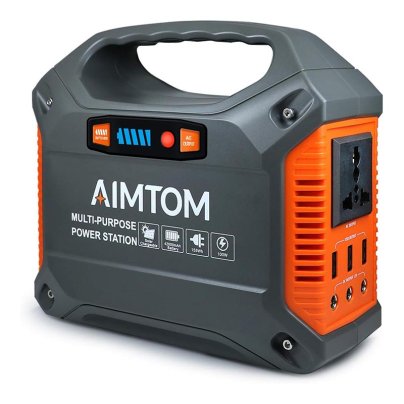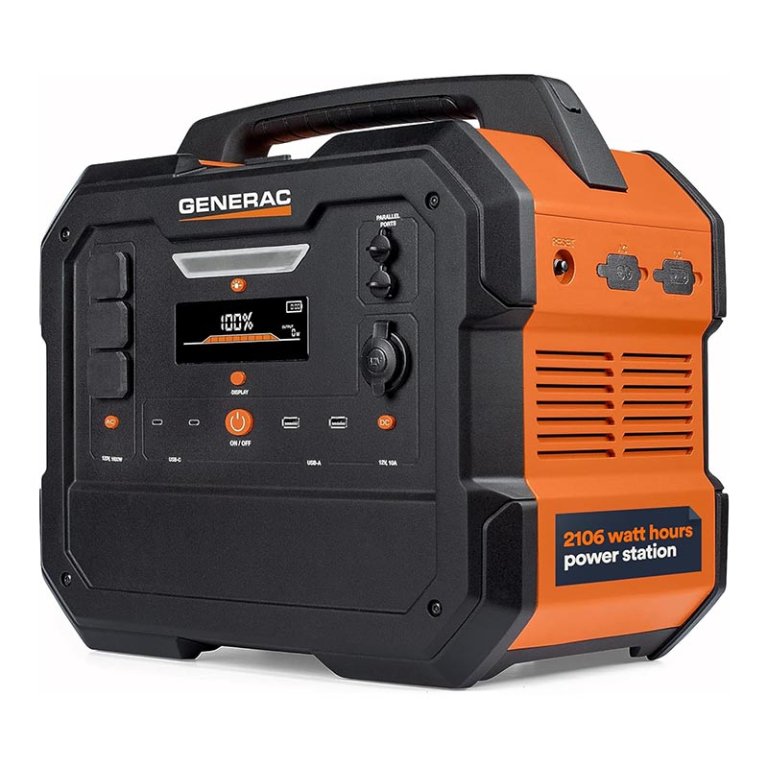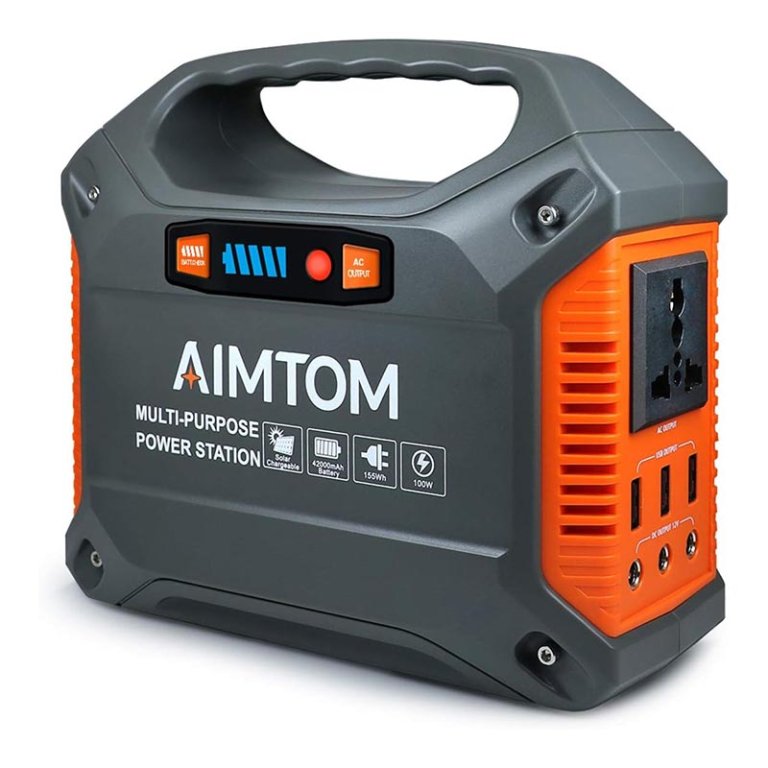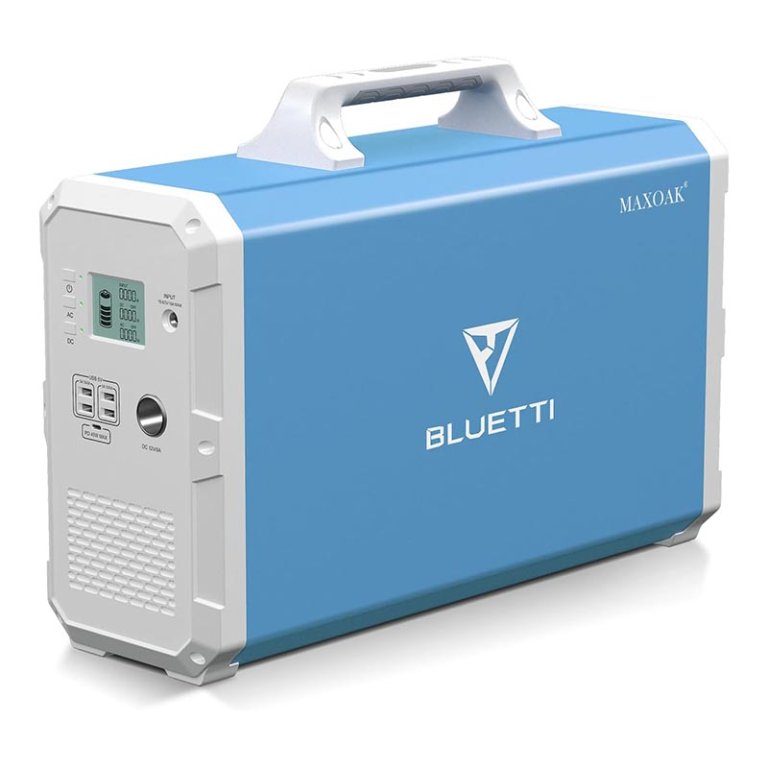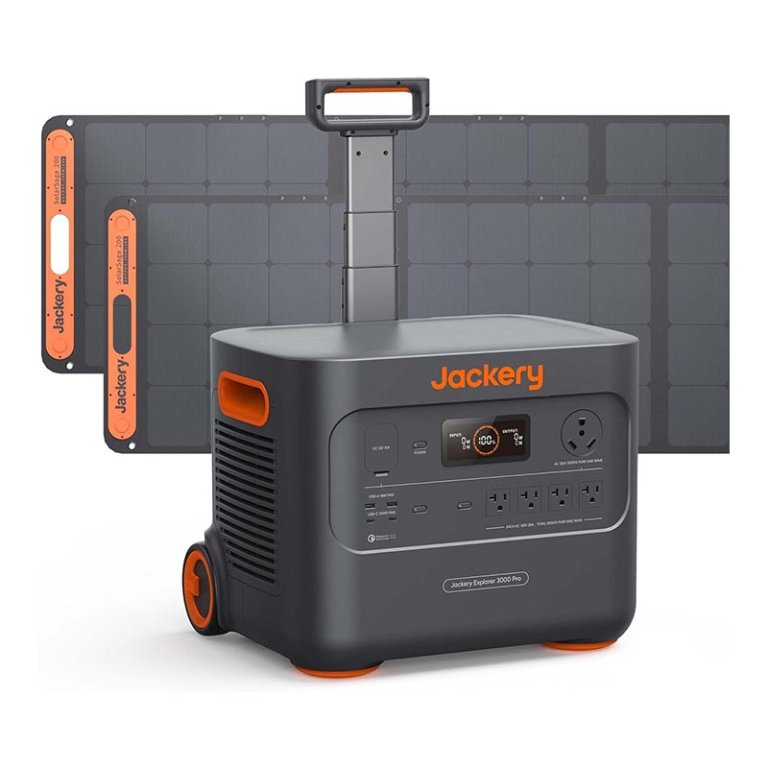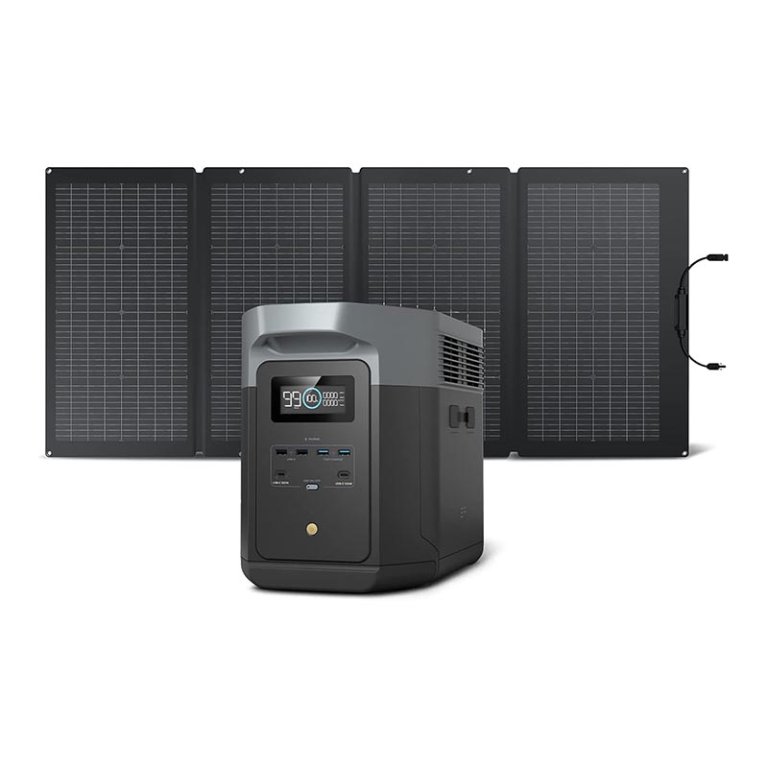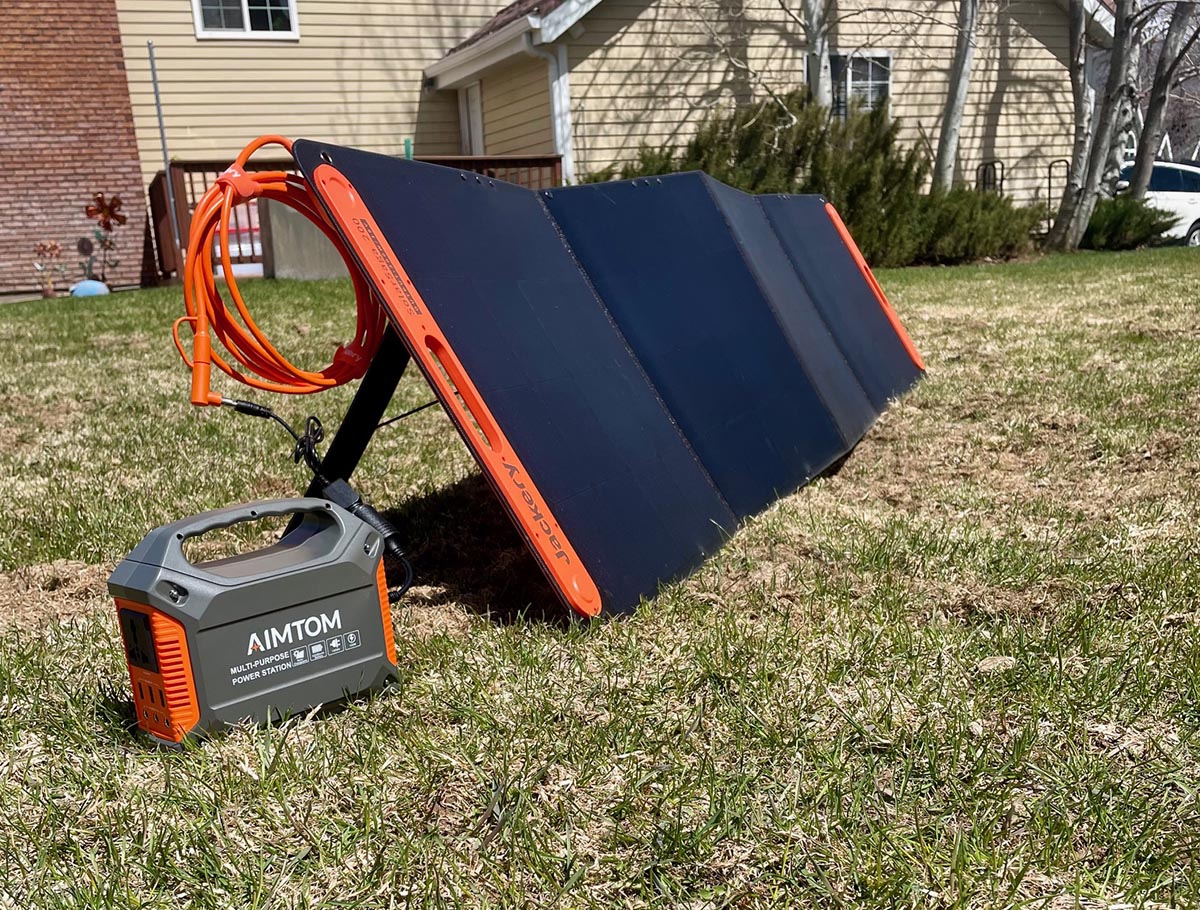
We may earn revenue from the products available on this page and participate in affiliate programs. Learn More ›
Harnessing the sun to create backup power is an eco-friendly alternative to fuel-guzzling gasoline or dual-fuel generators. Also called solar “power stations,” solar generators feature high-capacity batteries that store energy that can be used to power appliances and digital devices. Unlike traditional generators, they’re safe to use indoors and virtually silent when in operation.
Solar-based battery technology has come a long way in the past few years, and we wanted to see just how good today’s solar power generators were at producing and storing power, so we decided to test them ourselves. We had to know how well they performed in real-life testing before we could recommend specific models to our readers.
Though gasoline and propane generators have more power, fuel is expensive and not always accessible. Read on to learn how to shop for a solar generator and to find out how the following models fared in our hands-on tests. While these products vary by capacity, best use, and cost, each one performed well enough to earn a spot on this lineup of the best solar generators.
- BEST OVERALL: Generac GB2000 Portable Power Station
- BEST BANG FOR THE BUCK: Aimtom PowerPal X 155Wh Portable Power Station
- BEST MIDRANGE: Maxoak Bluetti EB150 1500Wh Portable Power Station
- BEST FOR SMALL HOMES: Maxoak Bluetti EB240 2400Wh Solar Power Station
- BEST HEAVY-DUTY: Jackery Solar Generator 3000 Pro
- BEST FOR OUTDOORS: EcoFlow Delta 2 Max Solar Generator
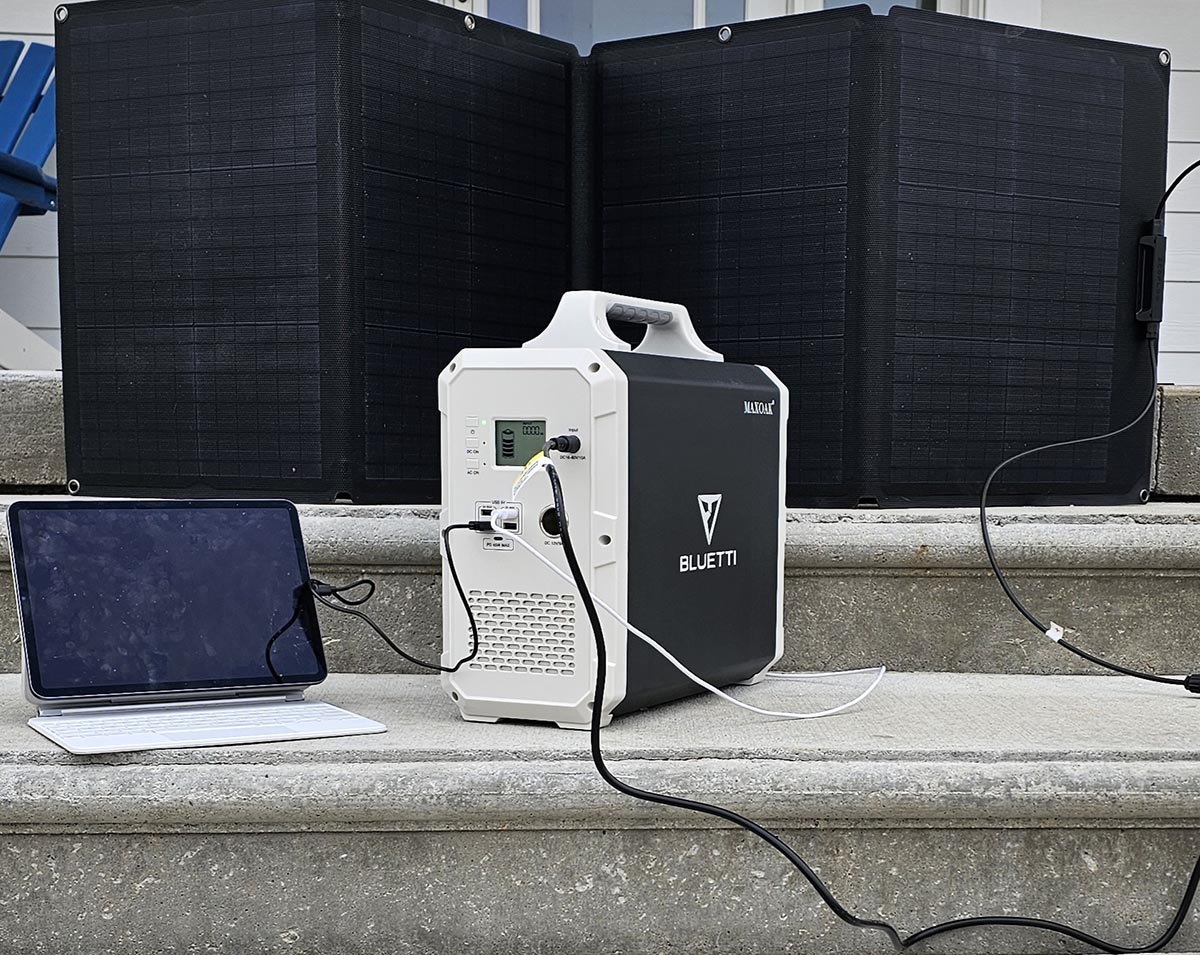
Before You Buy a Solar Generator
The portability of solar-powered generators makes them ideal for traveling, camping, and outdoor events because they are easy to pack, store, and move. The units are also a solid backup source for when emergencies occur at home due to severe weather or blackouts.
While solar generators are a clean energy source, they do have limitations because of their wattage capacity and slow recharging. A high-capacity solar backup generator can often produce enough power to keep the lights on or run televisions and electronic devices for hours. However, they don’t harness enough power to run all of the large appliances in a residence at one time or for an extended period. In general, a solar generator for house use will run only a few low-wattage appliances.
How We Tested the Best Solar Generators
We researched more than 25 portable solar generators, paying close attention to type, power output, weight, ports, and other special features. We considered brand names to an extent; manufacturers like EcoFlow and Jackery are highly respected generator brands. We also considered quality, ease of use, and customer satisfaction.
We narrowed our list to several top-rated solar generators in various categories. Then, our team members put them to the test in their own homes, charging them outdoors with solar panels and noting how much energy they offered to power a range of appliances and devices.
Each solar generator was tested using a rubric—the better it performed on a test, the more points it received. After completing the tests, we averaged the points to determine the best performers and to designate the best uses for each model.
Testing Stats
- Products tested: 6
- Hours spent testing: 20+
- Tests performed: 3
- Price range: $105 to $3,700
Our Top Picks
The following products represent some of the best solar generators manufactured by reputable brands in terms of size, power, battery capacity, and special features. While they vary in storage capacity and available ports, each one was a standout in our hands-on tests. If you’re looking for a way to use solar energy to produce backup power, one of the following generators will fit the bill.
Best Overall
Generac GB2000 Portable Power Station
Pros
- Battery generator for home use; charges to full capacity in 3 to 4 hours via AC
- Offers enough power to run tools, appliances, and digital devices
- Designed for emergency, off-grid, or recreational use
Cons
- Does not come with solar panels, but they may be purchased separately
Product Specs
- Wattage: 3,200 peak watts and 1,600 running watts
- Watt-hours: 2,106
- Charging source: Alternating current (AC) or solar
- Outlets/ports: Three 120 volt (V)-13.3 amp (A) AC outlets; one 12V direct current (DC) port; 2 USB-A ports; 2 USB-C ports; wireless charging pad
- Weight: 43 pounds
Our Ratings: Ease of Use 5/5; Noise 5/5; Portability 3.5/5; Power 4.5/5; Value 5/5
Solar generators have come a long way in the past decade, and nowhere are the improvements more apparent than with the Generac. This solar-powered generator delivers up to 3,200 peak and 1,600 running watts via three AC ports, four USB ports, a 12V DC port, and a wireless charging pad. It’s well suited as an emergency backup or a remote power source for tailgating and camping.
The Generac does not come with solar panels, but we charged it using our own Ecoflow 400-watt portable panels. With the Ecoflows, we got the generator from 28 percent to 100 percent in just under 5 hours. Charging time may vary greatly, however, as it depends on the capacity of the solar panels you use and the amount of sunshine the panels receive on any given day.
Once charged, we powered several household appliances, including a fridge and lamps, multiple electronic devices, and even a miter saw. The Generac expends only as much power as you use, making it more energy efficient than many fuel-powered models that generate a set amount of wattage whether you’re using the power or not.
We were impressed by this solar generator, but it is a tad heavy at 43 pounds. Its weight makes it challenging to carry for a long time, but it comes with a sturdy nonslip handle that helps when moving it short distances.
Read our full review: Generac GB2000 Portable Power Station
Get the Generac solar generator at Amazon, Lowe’s, Tractor Supply Co., The Home Depot, Walmart, or Generac.
Best Bang for the Buck
Aimtom PowerPal X 155Wh Portable Power Station
Pros
- Lightweight and compact design is highly portable for powering small electronics devices
- Can be charged with solar power, a wall outlet, or a car port
- Built-in emergency solid-state and blinking flashlight is bright and convenient
Cons
- Aimtom’s compatible solar panels are currently unavailable in the U.S.
- Power output is limited; best for phones, laptops, and tablets or small appliances like a mini fridge or CPAP machine
Product Specs
- Wattage: 150 peak watts and 100 running watts
- Watt-hours: 155
- Charging source: AC, solar, or DC
- Outlets/ports: One 110V AC outlet; 3 USB-A ports; three 12V DC ports
- Weight: 3.48 pounds
Our Ratings: Ease of Use 4/5; Noise 5/5; Portability 5/5; Power 3/5; Value 5/5
This small solar generator from Aimtom is lightweight, compact, and convenient. It has one AC outlet, three USB-A ports, and three 12V DC ports. Since its output caps at 150 peak watts and 100 running watts, it’s best for charging devices and powering small electronics or appliances.
The Aimtom solar generator was easy to test, though limited. It was great for charging a phone, tablet, and set of wireless earbuds on a road trip (it was still at 5 bars after 6.5 hours), but we didn’t have much use for its three DC ports. The AC plug was a nice feature, though, and we were able to plug in a small handheld vacuum to charge.
In terms of input options, this lunchbox-size solar generator features the option to recharge via a wall outlet, car port, or solar panel (not included). We waited several months for Aimtom’s solar panels to come back in stock in the U.S., but they never did. We finally gave up and used a Jackery solar panel for charging. Thanks to the included adaptors, we hooked the two products together without issue, and the battery indicator went from zero to five in just 4 hours.
Get the Aimtom solar generator at Amazon or Aimtom.
Best Midrange
Maxoak Bluetti EB150 1500Wh Portable Power Station
Pros
- Green energy source that’s great for those who want an eco-friendly option
- Suitable for use with appliances, including those for the kitchen and electronic devices
- Has a built-in carrying handle and is suitable for indoor/outdoor use
Cons
- Intended for light use; not meant for powering large appliances
Product Specs
- Wattage: 1,200 peak watts and 1,000 running watts
- Watt-hours: 1,500
- Charging source: AC or solar
- Outlets/ports: 2 AC outlets, 4 USB-A ports, 1 USB-C port, one 12V DC port
- Weight: 37.9 pounds
Our Ratings: Ease of Use 5/5; Noise 5/5; Portability 4/5; Power 4/5; Value 4/5
The Maxoak Bluetti EB150 has enough power to run small appliances, charge electronic devices, and even run smaller power tools. It features two AC outlets, four USB-A ports, one USB-C port, and a 12V vehicle outlet.
It doesn’t come with solar panels, so we used our own for testing—Ecoflow’s 400-watt portable panels. With our panels, we were able to fully charge the EB150 from 25 percent capacity to 100 percent capacity in just 3.5 hours on a sunny day. Charge time will vary depending on the capacity of the panels you use and the available sunshine.
Once fully charged, we plugged in various appliances and tools, including a mini fridge, corded drill, blender, and several lamps. We also charged a laptop, tablet, and cell phone. Like all power stations, the EB150 only expends power as it’s drawn—meaning it doesn’t waste energy. That makes it more efficient than some gas-powered generators that burn the same amount of fuel whether anything’s plugged in or not.
The EB150 is relatively heavy, weighing in at 37.9 pounds. We could easily carry it around the house, but it would become burdensome on a long hike.
While it’s not intended for heavy-duty use—it will run an appliance or power tool, but it won’t run several tools simultaneously—this solar generator is a good option for those who live in sunny climates and need remote energy sources.
Get the Maxoak Bluetti EB150 solar generator at Amazon or Maxoak.
Best for Small Homes
Maxoak Bluetti EB240 2400Wh Solar Power Station
Pros
- Produces a low 43 decibels when charging via wall outlet and absolutely no noise when used as a power source
- 2,400 watt-hour capacity is higher than that offered by many solar generators, especially at such a great price
- Foldable solar panels include kickstands, mounting holes, and handles for transport
Cons
- Battery icon shows charge level rather than an exact percentage
- Operating temp on this solar portable generator is 32 to 104 degrees Fahrenheit; not compatible with extreme weather
Product Specs
- Wattage: 1,200 peak watts and 1,000 running watts
- Watt-hours: 2,400
- Charging source: AC or solar
- Outlets/ports: Two 110V-20A outlets; one 12V DC outlet; 1 fast-charging USB-C port; 4 USB-A ports
- Weight: Generator: 48.5 pounds; solar panels: 14.3 pounds each
Our Ratings: Ease of Use 4/5; Noise 4/5; Portability 5/5; Power 5/5; Value 5/5
The Maxoak Bluetti EB240 is a virtually noiseless generator, emitting no sound when powering devices and appliances and measuring only 43 decibels when charging via an AC outlet. In testing, we used the Bluetti to run a mini fridge, corded stick vacuum, CPAP machine, and several other small appliances and cordless tool chargers. We even plugged a washing machine into it and were impressed that the generator had enough peak and running power to do a full cycle without tripping.
This small generator weighs under 50 pounds and is just a bit bigger than a large briefcase. It has two AC outlets, one DC plug, and five USB ports, making it best suited for emergency use, portable power needs, or camping. It offers a 2,400-watt-hour capacity that’s higher than many generators in its price range.
The only real downside to the Bluetti was the way it displays power status. Rather than showing an actual numerical percentage, this generator uses a battery icon divided into five segments. We found this confusing, as we never knew how many remaining hours each segment potentially equated to. After charging the Bluetti for 6 hours using its two 200-watt solar panels, the generator showed a charge of three segments. It took another 6 hours for it to reach the full five.
Still, for 1,000 watts of power and two 200-watt foldable solar panels (with pass-through charging!), this portable silent generator is an excellent value that provides peace of mind for basic backup needs.
Get the Maxoak Bluetti EB240 solar generator at Amazon (no solar panels) or Maxoak (2 solar panels).
Best Heavy-Duty
Jackery Solar Generator 3000 Pro
Pros
- 10 outlets provide plenty of options for powering multiple items at once
- Goes from 0 to 100 percent charged in under 2.5 hours using a wall socket
- As quiet as a whisper during charging and operation at just 38 decibels
- Solar panels’ IP67 waterproof rating ensures they’re capable of withstanding harsh weather
Cons
- App needs more development to offer notifications and improve accuracy
- Cumbersome to move at almost 64 pounds, even with wheels and handle
Product Specs
- Wattage: 6,000 peak watts and 3,000 running watts
- Watt-hours: 3,024
- Charging source: AC, solar, or DC
- Outlets/ports: Four 120V-20A outlets; one 120V-25A outlet; one 12V DC port; 2 USB-C ports; 2 USB-A ports
- Weight: Generator: 63.93 pounds; solar panels: 17.5 pounds each
Our Ratings: Ease of Use 5/5; Noise 4/5; Portability 4/5; Power 4.5/5; Value 4/5
With 10 ports and the ability to supply 6,000 peak watts and 3,000 running watts of electricity, the Jackery 3000 Pro solar generator has enough juice for a family camping trip or use during an emergency.
We absolutely loved using the Jackery solar generator during our tests. The machine requires almost no setup, save for downloading and pairing the Jackery app if desired. We did struggle with the solar panels a bit at first, though. At this stage in testing, using solar panels was new, and it took us a little time to figure out how to position them for maximum solar input. Yet since the Jackery supports pass-through charging, we used it to charge a cordless tool while fiddling with finding the right panel angle. We also used it to power a mini fridge while charging a handheld vacuum and to run a complete home office setup during a scheduled power outage.
With small features like the generator’s cord keepers and telescoping handle to the solar panels’ kickstanding feet and included carrying cases, it’s obvious that this small solar generator was made by people who actually use their products. You may pay a little more for their attention to detail, but we think it’s worth it.
Read our full review: Jackery Solar Generator 3000 Pro
Get the Jackery solar generator at Amazon (2 solar panels), Lowe’s (1 solar panel), The Home Depot (1 solar panel), or Jackery (2 solar panels).
Best for Outdoors
EcoFlow Delta 2 Max Solar Generator
Pros
- Power station charges via AC, solar, or DC for emergency or on-the-go use
- Users can connect 2 extra batteries (sold separately) for up to 6,144 watt-hours
- Charges in as little as 43 minutes with simultaneous solar and AC charging
- Supplies power to as many as 15 devices at the same time
- Lithium iron phosphate (LFP) battery has extended lifespan (10 years with daily use) compared to lithium ion
Cons
- Does not have a 30-amp outlet to power an RV
- Sensitive to excessive heat or cold temperatures
Product Specs
- Wattage: 4,800 peak watts and 2,400 running watts
- Watt-hours: 2,048
- Charging source: AC, solar, or DC
- Outlets/ports: Six 120V-15A AC outlets; 2 USB-A ports; 2 USB-A fast-charging ports; 2 USB-C; one 12V DC; 2 DC5521/barrel ports
- Weight: 50 pounds
Our Ratings: Ease of Use 4.5/5; Noise 5/5; Portability 4.5/5; Power 4.5/5; Value 4.5/5
Portable power generation and storage could not be much more convenient than with the EcoFlow Delta 2 Max solar generator. The unit we tested included the rechargeable 2,400-watt power station and a 200-watt trifold solar panel with its own stand. Users have the option to expand both the solar input and power storage capacity by purchasing additional solar panels or extra batteries.
This EcoFlow Delta 2 Max is one of the more rugged yet lightweight power stations of its kind. It features a LFP (or LiFePO4) battery, which has nearly twice the expected life span of traditional lithium-ion batteries: 3,000 charging cycles or about 10 years of daily use. Users can charge it with solar panels, a wall outlet, or a 12-volt car outlet, and it offers 15 electrical outlets to power up most home appliances and small electrical devices.
During testing, we charged the EcoFlow using a single 200-watt solar panel, which took about 12 hours. We then plugged in our fridge and used the unit’s large digital display to monitor output and projected runtime based on current usage. When we started the test, the display showed 99 percent charge and 14 hours of runtime remaining. After 6 hours, the charge level read 40 percent, with 6 hours remaining. Then, 10 hours after starting, we ended the test with a 5 percent charge still showing on the battery life indicator. It was an impressive performance for emergency use, and more than enough output to run a coffee maker and some string lights during a weekend in the woods.
Read our full review: EcoFlow Delta 2 Max Solar Generator
Get the EcoFlow solar generator at Amazon (1 solar panel), The Home Depot (solar panels sold separately), Walmart (solar panels sold separately), Campervan HQ (1 solar panel), or EcoFlow (1 solar panel).
Jump to Our Top Picks
What to Consider When Choosing a Solar Generator
While searching for the best solar-powered generators available for home or travel, consider the intended use; how and where you plan on using a solar generator will determine the size, power, and capacity of the unit you’ll need.
Purpose and User Activity
Solar generators are useful for anyone who travels and stays in remote off-grid places. Conversely, shoppers may simply desire a reliable backup source of energy for their home to prepare for the occurrence of a natural or man-made disaster.
If the primary purpose is travel, look for solar generators that help make traveling simpler. RV connectivity allows you to power appliances on the road. Car-charging capabilities make it convenient to drive and charge solar generators without having to stop and set up solar panels.
Size and Solar Input
When choosing the right size solar generator, keep in mind battery capacity and power requirements so that you can avoid overloading it. Most solar generators can keep portable electronics, smartphones, tablets, power tools, small appliances, and cordless tools powered up for hours. However, buyers may need a separate generator, say, to keep a refrigerator running for an entire day.
Solar input refers to the solar panels. The solar panels collect and convert sunlight into energy that is stored in the generator’s battery. Ample solar input controls a generator’s operating time and how long it takes to recharge.
The solar panels used in conjunction with a portable solar generator are mobile and easy to manipulate. Unlike the panels found on residential or commercial properties, they are smaller in size and have a lower wattage capacity, which means less solar input than their larger counterparts.
Power Requirements
The output of power from a solar generator should match electrical needs. Battery power is measured in watts, which is the maximum amount of power a generator provides when it’s running. Battery capacity—referred to as watt-hours—is the total amount of stored energy.
When the generator is in operation, the watts represent the rate of power flowing from its battery to an electrical device, and the watt-hours are the maximum level of energy it can deliver. For example, a solar generator with 500 watt-hours can store a total of 500 watts when it’s fully charged. Thus, a 500-watt solar generator is only able to power electrical appliances and devices that don’t exceed 500 watts to run.
Battery Storage Capacity
The battery in a solar generator is where the energy captured from the solar panel is stored for later use. Solar generators usually have lithium-ion or lead-acid batteries. Battery storage allows users to run the generator at night or on days with limited sunlight.
The capacity of the batteries determines the duration of the generator. The more power an electronic device requires, the faster the battery charge will run out. The length of the battery charge is also based on the number of devices drawing power from the generator at the same time.
A larger battery capacity is necessary to power electrical appliances that require higher watts. Lower capacity is sufficient for lights, cell phones, and laptops. For instance, a 500-watt solar generator can power an LED light for 100 hours, while it will only power a mini fridge for about 10 hours.
Inverter Rating
Direct current and alternating current are the two forms of electricity. DC is electricity that flows only in a forward direction. AC is electricity that flows both forward and backward. The energy harnessed by solar panels is DC. A solar inverter generator converts low DC power from the batteries to AC power for usage.
The inverter rating translates to the maximum watts a solar generator can extract at any time. For example, a 1,500-watt inverter can draw up to that amount of wattage in AC power. Keep in mind that the inverter size or rating doesn’t always correlate to a solar generator’s overall firepower. Battery storage is also important.
Expandability of Power
Eventually, you may want to expand the capability of your solar generator. However, upgrading a solar generator is not always feasible.
Expanding power is based on the sustainability of the charge controller, which sends power in one direction from the solar panels to the batteries. As the integral component of the solar generator, the primary job of the charge controller is to protect the durability of the batteries.
The charge controller can only process the maximum number of watts and voltage that it’s built to manage, so you may not be able to expand beyond its charging ability. If battery capacity doesn’t support additional solar panels, power expandability is unachievable.
Types of Solar Generators
In areas with frequent power outages, a generator provides an interim source of electricity. Two types of solar generators are available for at-home use: solar backup generators and portable solar generators. Both generators provide solar power but differ in terms of wattage capacity, energy storage, and cost.
Solar Backup Generators
Solar backup generators are designed to power up when the electrical grid fails and are an efficient alternative to installing a complete system. These generators use several batteries to store energy for high-wattage output. They provide sufficient backup power to turn on lights, televisions, computers, and small to midsize appliances.
Typically, it takes less than 48 hours to charge a solar backup generator to full capacity, but the time can vary depending on the size of the solar panels and the amount of sunlight. You can keep these generators either indoors or outdoors. The disadvantage of solar backup generators is their weight, making them somewhat difficult to move. Additionally, a generator that is large enough to power an entire residence is expensive.
Portable Solar Generators
Portable solar generators are lightweight, so you can take them anywhere. They are ideal for homes, cabins, campsites, RVs, cars, and boats. Some generators are equipped with a pull handle or attached handgrip for effortless transporting. Solar panels recharge the battery in a portable solar generator.
Portable solar generators do have drawbacks. They may either have inadequate wattage capacity to power larger appliances, such as refrigerators, dishwashers, washing machines, hot water heaters, and sump pumps, or may not be capable of powering multiple devices at the same time.
If they use low-wattage solar panels, it may take a long time to recharge the generator. On the plus side, portable solar generators don’t emit noise or carbon dioxide, are affordable, and are low maintenance, unlike gas generators.
Tips for Using a Solar Generator
With a multitude of solar generators from which to choose, shoppers may find it difficult to decide which one fits their requirements. To begin, they will want to pinpoint how and where they plan to use it.
Solar generators are available in a variety of sizes with various wattage and storage capacities. They are primarily for powering homes during electrical outages or for outdoor activities like camping, hunting, sailing, fishing, and traveling. Solar generators are also an ideal power source for outdoor events, such as parties, festivals, craft fairs, and farmer’s markets.
How much shoppers want to spend on a solar generator is another important consideration. As solar generators increase in size and capacity, so does the price. Keep in mind that most solar generators don’t include solar panels, so that extra purchase will add to the expense.
- The solar generator should match shoppers’ intended purpose.
- It’s important to select the appropriate size, wattage, and storage capacity for usage.
- Focus on the features that suit an individual’s plans for the generator, such as the number of plug-in ports, charging speed, portability, carrying handle, flashlight, expandability, and weight.
The Advantages of Owning a Solar Generator
Owning a solar generator frees users from dependency on fossil fuels when they want a backup system for emergencies, traveling, or camping. Plus, solar generators are portable and compact, so they are easy to store and move, unlike huge gas-powered generators.
Solar generators are also quieter, safer, and require minimal maintenance since they don’t have motors, moving parts, or emit harmful carbon dioxide. This alternative kind of generator is a green solution that collects energy from the sun to store in its battery and then produces power when it’s in operation.
The charging rate and power capability of a solar generator depend on its size, so shoppers will want to consider carefully where they’ll want to use it and how many electrical devices and appliances they want it to power.
- No fuel is needed to operate a solar generator.
- It’s a clean, renewable source of energy.
- A solar generator is low maintenance.
FAQs
It makes sense to own a solar generator so you’re not left without a source of power either during an electrical outage at home or simply while enjoying outdoor activities and travel. The portability of solar generators makes them ideal for packing and toting on trips, and they’re especially handy for stowing and using in RVs, cars, boats, and cabins. If you still have some questions about which solar generator power option might be best for your needs, check out some of the most frequently asked questions about solar generators and their corresponding answers.
A solar generator works when a solar panel converts sunlight into DC electricity that passes through the charge controller. The solar energy is stored in the battery, and thus a solar inverter generator turns the electricity into usable AC power.
A solar generator most likely won’t power every item in your house at once. For that, you’d need an entire solar power system. Depending on the size of the generator, it can charge and power a variety of large and small appliances, electronic devices, and medical machines.
To choose a solar generator, think about your intended use and budget; potential state and local incentives; as well as how much battery capacity and wattage you need to power your appliances, electronic devices, and other equipment.
The size of the solar generator you need depends on the amount of wattage you require to power your devices and the duration time for charging.
Meet the Testers
Glenda Taylor is a contractor, product tester, and writer. With experience in both residential and commercial building applications, she focuses primarily on construction, woodworking, and DIY tools and techniques.
Michelle Larson is an editor, product tester, and writer. She’d rather spend a little more up front than buy a tool or appliance twice, so she loves every opportunity she gets to test whether recommended items are going to last.
Additional testing performed by Mark Wolfe. The Bob Vila test team is made up of contractors, remodelers, home design enthusiasts, and freelancers from across the nation. Each member is dedicated to delivering high-quality product information to our readers so they can shop with confidence, knowing the products they purchase have been fully tested and vetted.
Additional research was provided by Donna Smith.
